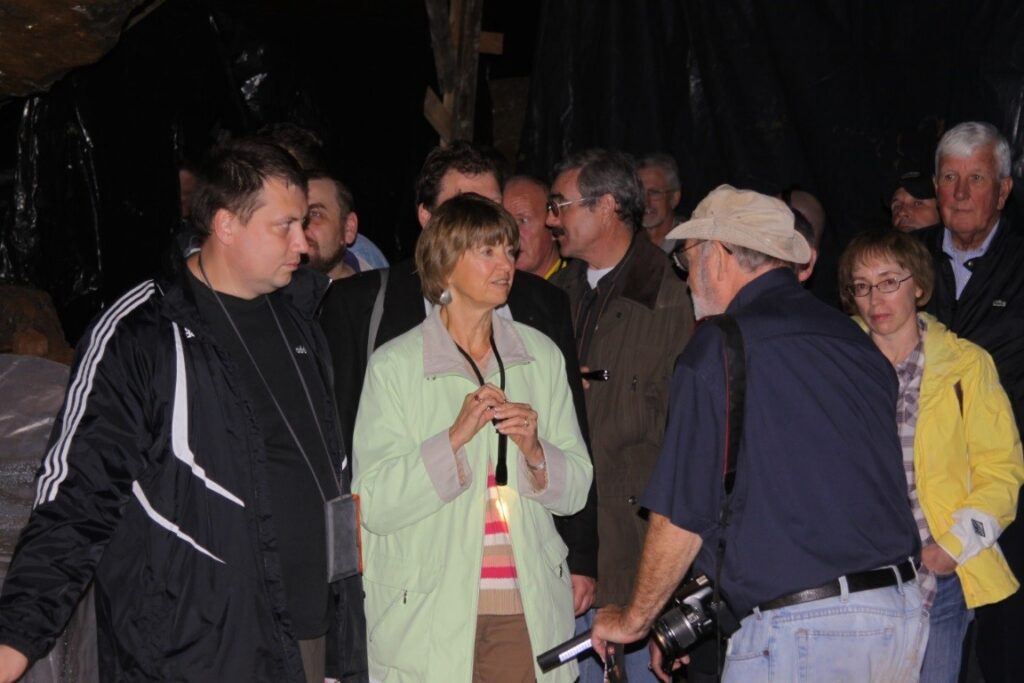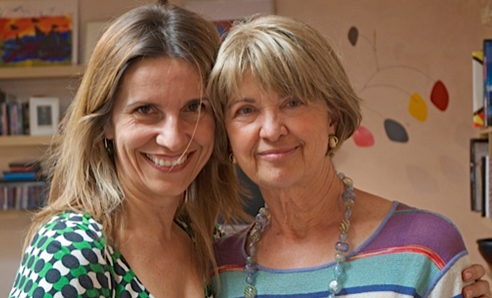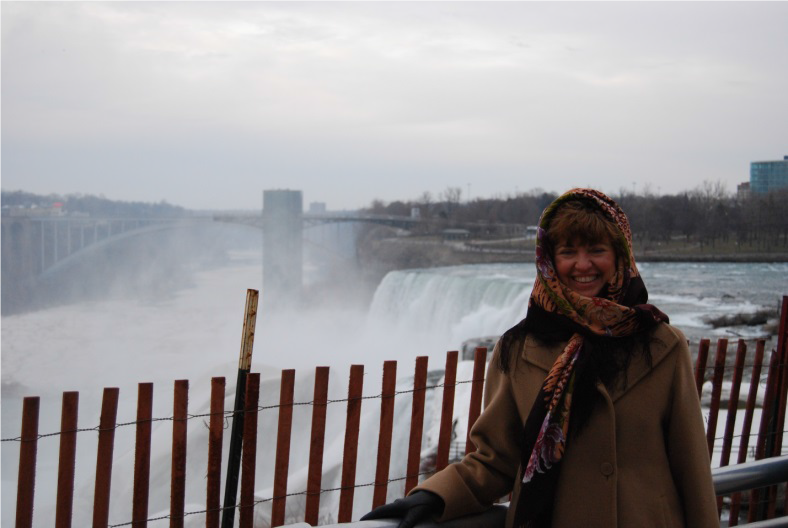Lab-to-Lab: US-Russian Lab-to-Lab Collaboration Story [Archived]
< Back to Interviews
Los Alamos, February 2017
Olga Martin serves as the Program Manager in Los Alamos National Laboratory Global Security Directorate. In her current position, Olga oversees Los Alamos programmatic activities for DOE-NNSA Offices of Nonproliferation and Arms Control and International Security, managing LANL technical work in international nuclear safeguards and security, nuclear controls, verification, and nonproliferation policy.
A tribute to Nellie Schachowskoj
The interview below is Olga’s tribute to her late friend and mentor, Nellie Schachowskoj, who played a key role in LANL’s lab-to-lab efforts.
Q: How did you become involved in the lab-to-lab?
Olga Martin: I came to LANL as a student in mid 90s, and was very fortunate to start working as an intern in the LANL Center for International Security Affairs (CISA), led at various times by such distinguished scientists and experts as Steve Younger, John Shaner and Paul White. Before I got hired at CISA, I had a phone interview with Sergej Schachowskoj, the head of Laboratory’s Translation and Interpretation Service at the time. This was my first “real” job interview.
After talking with Sergej, and hearing him speak about his meaningful work with the American and Russian nuclear scientists, I remember there was nothing that I wanted more than to get a position on Sergej’s team. In addition, I recognized Sergej’s last name from my Russian history courses, and when he confirmed that he indeed was a direct descendant of one of the oldest noble families in Russia (most of whom fled to the West after 1917 Bolshevik Revolution), it made it all even more exciting for me. After the interview, I remember thinking in my quite skeptical Eastern European student’s mind that if these two weapons labs, former cold war adversaries, are now so closely working together to secure dangerous nuclear materials, the humankind is in a much better place than I thought it was…
My enthusiasm for the program that Sergej so passionately described during the interview must have shined through, as I was hired right after. Although I never had a chance to meet Sergej in person (he passed away of an aggressive form of cancer just before I came to LANL), my interview with him was a wonderful introduction to my professional life, and many years of fascinating engagements in U.S.-Russian nuclear security and nonproliferation programs.
After Sergej passed, his wife Nellie Schachowskoj, a competent Russian linguist in her own right, bravely took over the leadership of his team, and I had the privilege of being a part of this team for several years. Nellie continued the impressive work that Sergej started, including the updates to the first LANL English/Russian and Russian/English Glossary of Terminology for Nuclear Materials Control and Accounting. As the cooperative nuclear security programs evolved, there was a strong need for making the technical terminology consistent, to help streamline the communications. The Glossary was a result of many technical meetings, negotiations, training courses, and other interactions during the implementation of the lab-to-lab activities. Sergej developed this Glossary with Hastings Smith, a brilliant leader and scientist in LANL’s Nonproliferation and International Security Division, and a key member of LANL lab-to-lab team. The Glossary has been a great resource for the technical Russian/English interpreters and translators in the nuclear sector ever since.

Nellie Schachowskoj interpreting for the scientists and engineers from the Siberian Chemical Combine (Tomsk-7, Russia) during an excursion that the US team organized after their meeting at PNNL in 2010.
Q: What impressions and experiences stand out in your memory – of people, places, culture, etc.?
Olga Martin: I mentioned Nellie Schachowskoj in my earlier response, and there is one charming episode that stands out for me, as it so well characterizes Nellie’s great skill in bridging the American and Russian cultures.
Around 1998, about a year after I started working at LANL, we were compiling a protocol from one of the MPC&A meetings with VNIIEF and LANL teams, held at the Center for International Security Affairs. As is usually the case when working on these important records of the meetings, the air was thick with disagreements on both U.S. and Russian sides, as to which points and conclusions should be reflected in this document. I, still an intern, was tasked with simultaneously documenting the topics that each side wanted to include, interpreting between the two parties, and typing in the translations, so that both groups can quickly come to an agreement on the final version of the protocol. The minute I started interpreting one side’s proposed language for the protocol, the other side interrupted and yelled their comments and counter-proposals, or asked for additional caveats or conditions. It was quite a stressful situation for me, and the fact that everyone was very tired after a long week of meetings didn’t help either. After a good 20 minutes of this back and forth between the Americans and the Russians, Nellie stood up and charmingly mustered in both groups, bringing the house to order. She gracefully shielded me from the involved arguments by sending only one person at a time to provide their suggested text and comments to me, so that I could finish at least the preliminary version of the document in peace, and move on to finessing it with the groups.
This was just one of many occasions that garnered my admiration of Nellie’s grace under pressure in often heated work situations, and her talent of communicating to both the American and the Russian sides with patience, accuracy, and humor.

The same meeting in October 2010. It was almost Halloween, and the Russian visitors were taken on a “cultural” tour to see one of the local tunnels turned into a haunted house.
Another episode that I still vividly remember is how Nellie and her team had to work several long days and nights to translate Sig’s presentation intended for a Pu Futures Conference. This presentation was delivered to Nellie extremely late for translation (there were several authors from LANL and LLNL contributing, so it took extra time to finalize). Since Sig was the Lab Director at that time, Nellie felt an added responsibility to ensure that his briefing would be translated accurately, to not damage the credibility of his work through poor translation (and also, to a certain degree, to show off to our linguist colleagues in Russia how well the American team can handle the translations into their native language). There was a lot of pressure due to the significant time restrictions. Through the whole process Nellie’s calm, competence and persistence guided her team in delivering the final product.

Olga Martin and Nellie Schachowskoj at Nellie’s retirement party hosted at Olga’s house. June 2014
As I remember, that Pu Futures Workshop turned out to be a great success, and I happen to think that it was also due to Nellie’s steady management of LANL’s translation effort. Afterward we heard through Sig that the Sarov colleagues were very appreciative and impressed with the high quality of translation of his brief, and competent use of the most accurate technical Russian language.
Q: Was lab-to lab a learning experience? In what way (if yes)?
Olga Martin: Phil Hemberger recalled in “Doomed to Cooperate” that Sig’s advice to him before he started working with the Russian colleagues was that he first needs to establish the “human connection” to build trust and a solid relationship, and only then he can make progress on his new project. Nellie’s most important contribution to the lab-to-lab programs was just that – serving as a bridge between the cultures, building connections between two different (yet so similar) worlds and breaking barriers in often tense and serious relationships.
A great example of this was our support of the 2000 Revision of A Review of Criticality Accidents that Norman Pruvost, Tom McLaughlin, and their team of LANL criticality safety experts wrote jointly with their colleagues from IPPE, VNIIEF, VNIITF, Kurchatov Institute, SKhK (Tomsk-7), and PA Mayak. The Report included all of the Russian criticality accidents, and also revised the US process facility accidents reported in the previous edition.

Nellie Schachowskoj. Picture taken at one of the Second Line of Defense (SDL) program meetings between 2008-2011.
In order to produce the Report, scientists from both countries needed to feel comfortable and trust each other with the facts surrounding the criticality accidents discussed, and how they would be shared. Nellie and her team helped establish that trust. Not only through the impeccable translation of initial correspondence, technical exchanges, analyses, the interpreting of many late night phone conferences between the two teams, but also by hosting the Russian scientists at Nellie’s home whenever they visited Los Alamos. It was through these personal connections that many of the technical details in the Report were clarified, often during the informal get-togethers after the meetings. I have a vivid memory of Sergey Vorontsov of VNIIEF playing soccer in Nellie’s back yard with one of her pre-teen twins, and then re-emerging (sweaty and exhausted from the impromptu soccer match) to interrupt a conversation among the LANL and VNIIEF scientists at Nellie’s dinner table by correcting a particular technical detail under a criticality accident being discussed at that moment.
Q: Did the cooperation experience change you in any way? Do you think that cooperation is necessary/important now?
Working on these projects raised my awareness of the value of taking the other side as equal, respected partners and be open to other ideas. I recall Carolyn Smith, one of Nellie’s excellent interpreters, who also provided cross cultural training to LANL staff, noting during one of her courses that the mind is like a parachute and that it only works when it is open…
During my work in lab-to-lab programs I saw firsthand how productive and meaningful it is to connect two somewhat different worlds and cultures through genuine interest and curiosity in each other’s technical work. Then, through that genuine interest, build a lasting relationship that continues to grow both on professional and personal levels. More importantly, the mutual sense of responsibility for keeping the nuclear materials protected was very powerful on both sides.
To answer the second question, working on lab-to-lab programs made me realize that people on both sides have to keep talking with each other, keep the engagement going, no matter how different their initial perspectives seem to be. Where there is no dialogue, there is no trust.

Nellie Schachowskoj. Picture taken at one of the Second Line of Defense (SDL) program meetings between 2008-2011.
Q: Do you believe Nellie’s work in Russia/with Russians made an impact?
Olga Martin: Nellie was not only my first manager at LANL, but also a great friend and someone I could turn to for counsel. I know she played similar roles for many of our lab-to-lab partners both in the U.S. and in Russia. When our Russian colleagues learned about Nellie’s passing last summer, Alexey Golubev’s reminiscences about Nellie’s contributions to the LANL-Sarov cooperation said it so well for many of us who had the privilege of working with Nellie:
“In Sarov, we will remember Nellie as a person who did so much for the LANL-VNIIEF, and Los Alamos-Sarov relationships. Nellie was a person who was able to build an atmosphere of trusting communication, improved understanding, able to do everything to get the people of the US and of Russia closer to each other. With her active participation there were many complicated and ambitious projects accomplished that until today are helping us ensure the security and safety of dangerous materials and facilities in Sarov. At the same time, Nellie was an extremely cultured person, and such an easy and pleasant partner in discussions.”
Additionally, Nellie’s colleagues in the Second Line of Defense (SLD) program in Russia said the following about her:
“Her energy, eagerness to make our meetings vivid and outstanding will always stay in our hearts. Visiting her house and getting to know [her children], Sasha and Marina, meant a lot to us. Nellie was a wonderful hostess, mother and wife. She had the wisdom and talent to live in style. She was an amazing bridge between the East and the West who aided mutual understanding, trust and hope. We are lucky to have met her on our way. Thank you for being with her in the hardest times. We will cherish the memory of Nellie for long years…”
